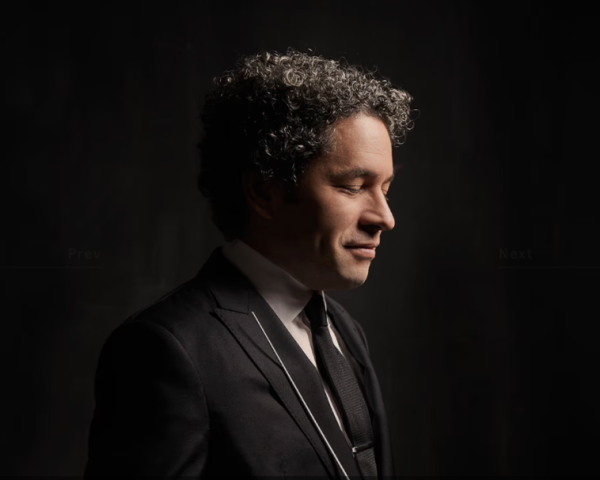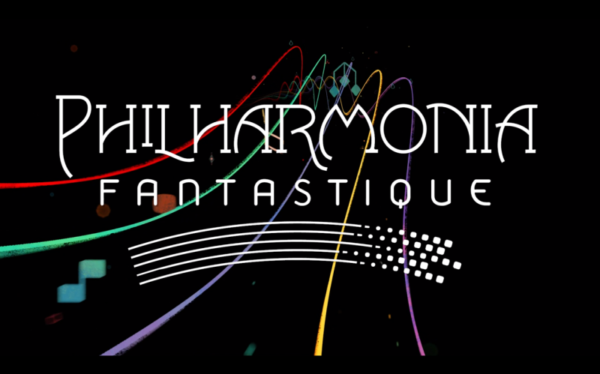COMPARED TO FANTASIA,
NOT SO FANTASTIQUE
Gustavo Dudamel and the Los Angeles Philharmonic concluded its orchestral season and its Spotlight on John Williams series on May 19 with a family-oriented program: Dudamel Conducts Harry Potter. Williams’ music is always an exciting proposition, but the program, the first half of which was dominated by another composer, played like a double-length “Symphonies for Youth” concert.
First up was “The Flight to Neverland” from John Williams’ grand and heart-tugging score to Hook (1991). Easy to listen to, and with a soaring melody — a near-rarity with new music at the Phil — this short piece, was for five minutes a thrilling way for the ginormous orchestra to start the program.
After this, the main piece of the first half was Philharmonia Fantastique: The Making of the Orchestra, written in 2022 by Mason Bates and played to the eponymous animated/live action film by director/writer Gary Rydstrom with story and animation by Jim Capobianco projected above the orchestra. The 25-minute short begins with the orchestra warming up against (what you’d be forgiven for mistaking as) the Netflix logo, and then dives into swirling chaos against a pulsating synthesizer while non-figurative animation swoops around on screen. The music shortly calms down and all the abstract shapes disappointingly coalesce into the Sprite character. Why can’t animation get beyond cute characters? Anyway, Sprite then plays the orchestra like a game of Simon, which got some gentle laughs from the audience.
Here is where the piece reveals itself to be an “intro to orchestra” work. Sprite then visits every major instrument in the orchestra. Sometimes it works, sometimes not. Each scene here begins with a portrait of the instrument, say, the cello. Then, just as I’m getting into the music, “Cello” pops up on screen, distracting me from the music and forcing me to read it. This portion works best when Sprite follows the physical path of the music and we see it fly along the paths of air inside the instruments. Interspersed throughout are explicit calls to Fantasia (1940), such as the “Sound Track” and musicians’ silhouettes. When not even the Disney company can create a worthy sequel to Fantasia, it’s best to not remind me of the most amazing and audacious animated feature to come out of America. And look so cheap while doing it. Also sprinkled are live-action shots of instruments and random musicians. The real players in front of me are more interesting than any video.
 Gustavo Dudamel
Gustavo DudamelWith the intro out of the way, the second half was The Magic of Harry Potter, a suite that covers Williams’ scores from the first three Harry Potter movies (he only did those three), written 2001-2004. For this, the Phil brought actor Freddie Stroma to narrate. His script had a rocky start, spouting boilerplate such as how much money the series made and how Harry Potter reminds us about “the wonder of books.” But after that, the narration became truly helpful in situating us as to how each movement fits in the story. As required, it started with the beguiling and haunting “Hedwig’s Theme.” There are ten selections in total, all in different styles, such as the wild and drunk “Night Bus,” and “Diagon Alley,” which is scratchy and bustling. In between, Stroma explained the type of music and what the orchestra was going to do. I eventually realized that this, too, is an intro-to-orchestra piece, seemingly designed to show off the versatility of the orchestra. “Nimbus 2000” was just the woodwinds, quiet, fast, and breezy, followed by “Quidditch,” a brass-only fanfare. Each section was about 3-4 minutes, not enough time to soak in the music.
Freddie Stroma
Presentation was wildly inconsistent. I was expecting the whole suite was going to be played to picture, but only selections 2 (“Aunt Marge’s Waltz”), 8 (“The Chamber of Secrets”), and 10 (“Harry’s Wondrous World”) had video; the latter two were montages which covered all the movies — including the ones Williams didn’t score. I found the video distracting and inappropriate, and was glad there weren’t any most of the time, but their use seemed random. There were also distracting flashing and swirling lighting effects during the start of each piece. On the one hand, they stopped after maybe 30 seconds (and, may I say, “Good Riddance”), but on the other hand it showed a lack of follow-through.
So, a program of three appetizers. I kept waiting for the main dish, but it never came. Accordingly, audience applause was tepid. People were getting set to leave when Dudamel came back to lead the orchestra in playing the main theme from E.T. the Extra-Terrestrial (1982), prompting the woman behind me to confidently exclaim, “Jurassic Park!” Same, girl. Same. Freed from having to play to picture, Dudamel let the music breathe and be deliciously bombastic, far more satisfying than the “E.T. in Concert” performance earlier in the season. This got the standing ovation that didn’t happen earlier, but I had a sneaky suspicion that we were just subjected to a Dudamel parlor trick.



{ 1 comment… read it below or add one }
A John Williams program = license to print money. Those shows sell well no matter how badly they’re planned or curated.